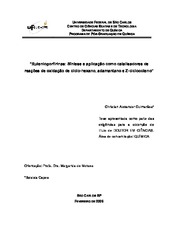Rutenioporfirinas: síntese e aplicação como catalisadores de reações de oxidação de ciclo-hexano, adamantano e Z-cicloocteno.
Abstract
The porphyrin ligands, mesotetraphenyl-21H, 23Hporphyrin,
meso-tetrakis(2-bromophenyl)-21H, 23H-porphyrin, meso-tetrakis(4- bromophenyl)-21H, 23H-porphyrin, meso-tetrakis(2-chlorophenyl)-21H, 23Hporphyrin, meso-tetrakis(4-chlorophenyl)-21H, 23H-porphyrin and meso-tetrakis(2,6-
dichlorophenyl)-21H, 23H- porphyrins, were synthesized by the condensation reaction of pyrrol with aldehyde, under reflux in acetic acid. After purification and characterization, ruthenium was inserted into these ligands. A solution of ruthenium trichloride was added to a solution of the ligand in 2-metoxymethanol and/or 2,2- metoxyethoximethanol under reflux and under a constant flow of carbon monoxide.
The complexes of first and second generations were obtained: (carbonyl)(methanol) mesotetraphenylporphyrinateruthenium(II), (carbonyl)(methanol) meso-tetrakis(2-
bromophenil)porphyrinateruthenium(II), (carbonyl)(methanol)meso-tetrakis (4- bromophenyl)porphyrinateruthenium(II), (carbonyl)(methanol)meso-tetrakis(2-
chlorophenyl)porphyrinateruthenium(II), (carbonyl)(methanol)meso-tetrakis(4-chlorophenyl)porphyrinateruthenium(II) and (carbonyl)(methanol)meso-tetrakis(2,6-
dichlorophenyl)porphyrinateruthenium(II). Using these complexes as starting reagents, a new methodology was developed for the direct synthesis of third
generation rutheniumporphyrin complexes, which are not yet reported in the literature. This methodology consisted of the reaction of the compounds of first and second generations with N-bromossuccynamide and/or N-chlorossuccynamide. The
poly-chlorinated and poly-bromated compounds:
(carbonyl)(methanol)mesotetraphenyl-β-octachloroporphyrinate ruthenium(II), (carbonyl)(methanol)meso-tetrakis(2-bromophenyl)-β-octachloro-porphyrinate
ruthenium(II), (carbonyl)(methanol)meso-tetrakis(4-bromophenyl)-β-octachloro porphyrinateruthenium(II), (carbonyl)(methanol)meso-tetrakis(2-chlorophenyl)-β-
octachloroporphyrinateruthenium(II), (carbonyl)(methanol)meso-tetrakis(4-chloro phenyl)-β-octachloroporphyrinateruthenium(II), (carbonyl)(methanol)meso-tetrakis (2,6-dichlorophenyl)-β-octachloroporphyrinateruthenium(II), (carbonyl)(methanol)
mesotetraphenyl-β-octabromoporphyrinateruthenium(II), (carbonyl)(methanol)mesotetrakis(2-bromophenyl)-β-octabromoporphyrinateruthenium(II), (carbonyl)(methanol)
meso-tetrakis(4-bromophenyl)-β- octabromoporphyrinateruthenium(II), (carbonyl)
(methanol)meso-tetrakis(2-chlorophenyl)-β-octabromoporphyrinateruthenium(II), (carbonyl)(methanol)meso-tetrakis(4-chlorophenyl)-β-octabromoporphyrinate
ruthenium(II) and (carbonyl)(methanol)meso-tetrakis(2,6-dichlorophenyl)-β- octabromoporphyrinateruthenium(II), were obtained using this new synthetic method
and sometimes using the conventional literature method. All the ligands and complexes were characterized by UV-VIS and Infrared spectrometry, elemental analysis CHN and nuclear magnetic resonance of hydrogen. After the
characterizations, all the compounds were used as catalysts in oxidation reactions of ciclohexane, adamantane and Z-ciclooctene with iodosylbenzene, hydrogen peroxide
and sodium hypochlorite as oxygen donors. The effect of the aging of the catalysts was investigated. Rutheniumporphyrins recently-prepared and stored for two years were used in catalyzed reactions. For all the complexes significant results for the yields and selectivity of the formed products were obtained for almost all of the systems and for all of the used oxidizers.
